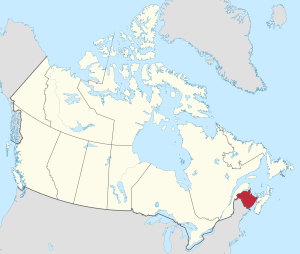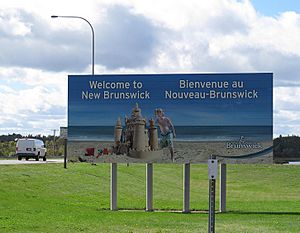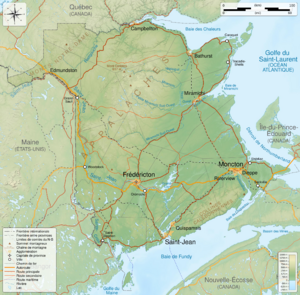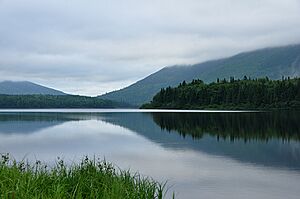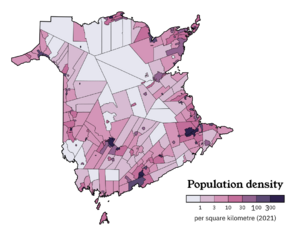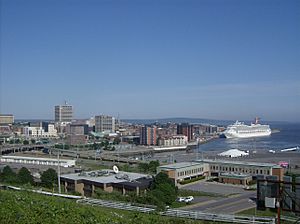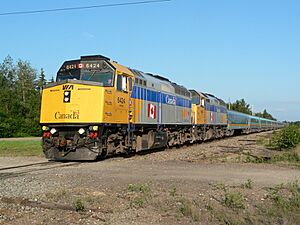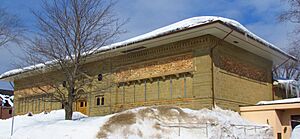New Brunswick facts for kids
Quick facts for kids
New Brunswick
Nouveau-Brunswick (French)
|
|||
|---|---|---|---|
|
|||
| Motto(s): | |||
| Country | Canada | ||
| Confederation | 1 July 1867 (1st, with Nova Scotia, Ontario, Quebec) | ||
| Capital | Fredericton | ||
| Largest city | Moncton | ||
| Largest metro | Greater Moncton | ||
| Government | |||
| • Type | Parliamentary constitutional monarchy | ||
| Area | |||
| • Total | 72,908 km2 (28,150 sq mi) | ||
| • Land | 71,450 km2 (27,590 sq mi) | ||
| • Water | 1,458 km2 (563 sq mi) 2% | ||
| Area rank | Ranked 11th | ||
| 0.7% of Canada | |||
| Population
(2021)
|
|||
| • Total | 775,610 | ||
| • Estimate
(Q2 2024)
|
850,894 | ||
| • Rank | Ranked 8th | ||
| • Density | 10.86/km2 (28.1/sq mi) | ||
| Demonym(s) | New Brunswicker FR: Néo-Brunswickois(e) |
||
| Official languages | |||
| GDP | |||
| • Rank | 9th | ||
| • Total (2017) | C$36.088 billion | ||
| • Per capita | C$42,606 (11th) | ||
| HDI | |||
| • HDI (2021) | 0.904 — Very high ([[List of Canadian provinces and territories by Human Development Index|12th]]) | ||
| Time zone | UTC-04:00 (Atlantic) | ||
| • Summer (DST) | UTC-03:00 (Atlantic DST) | ||
| Postal abbr. |
NB
|
||
| Postal code prefix |
E
|
||
| ISO 3166 code | CA-NB | ||
| Flower | Purple violet | ||
| Tree | Balsam fir | ||
| Bird | Black-capped chickadee | ||
| Rankings include all provinces and territories | |||
New Brunswick (French: Nouveau-Brunswick) is one of Canada's thirteen provinces and territories. It is part of the Maritime provinces and the Atlantic provinces.
New Brunswick shares borders with Quebec to the north and Nova Scotia to the east. It also touches the Gulf of Saint Lawrence and the Bay of Fundy. To the west, it borders the U.S. state of Maine. Most of the province (about 83%) is covered by forests. The northern part is home to the Appalachians mountains. New Brunswick has a continental climate, meaning it has snowy winters and warm summers.
The province covers an area of about 72,908 square kilometers. In 2021, it had 775,610 people living there. Unlike many places in Canada, only about half of New Brunswick's population lives in cities. The biggest cities are Moncton, Saint John, and Fredericton.
In 1969, New Brunswick passed a law called the Official Languages Act. This law made French an official language alongside English. This means people in New Brunswick can get government services in either English or French. About two-thirds of the people speak English, and one-third speak French. New Brunswick is also home to most of the Acadia cultural region and many Acadians. The French spoken here is called Acadian French, and there are seven different regional accents.
New Brunswick was first home to First Nations groups like the Mi’kmaq and Maliseet. In 1604, Acadia, the first New France colony, was started. For 150 years, Acadia was fought over by France and the United Kingdom. From 1755 to 1764, the British forced many Acadians to leave their homes. This event is known as the Great Upheaval. After this, and the Treaty of Paris, Acadia became British.
In 1784, many loyalists who supported Britain arrived after the American Revolution. This led to the official creation of New Brunswick as a separate colony from what is now Nova Scotia. In the early 1800s, New Brunswick grew quickly and became prosperous. In 1867, New Brunswick joined with Nova Scotia and the Province of Canada (now Quebec and Ontario) to form Canada. After this, industries like shipbuilding and lumbering faced challenges.
From the mid-1900s, New Brunswick was one of Canada's poorer regions. This changed over time with help from the Canadian government. Recently, more people have been moving to New Brunswick from other parts of Canada. In 2019, the province's total economic output was about C$38.236 billion.
Tourism is important to New Brunswick's economy. It supports about 9% of jobs. Popular places to visit include the Hopewell Rocks, Fundy National Park, Magnetic Hill, Kouchibouguac National Park, and Roosevelt Campobello International Park.
In 2023, New Brunswick changed how its local governments are organized. Many smaller areas were combined into 77 local governments and 12 rural districts.
Contents
What's in a Name?
New Brunswick got its name in 1784. It was named to honor King George III of Great Britain. He was also the prince-elector of Brunswick-Lüneburg in what is now Germany. The original Brunswick is also known as Braunschweig.
A Look at History
Early People and Explorers
The first people to live in New Brunswick were Paleo-Indians, about 10,000 years ago. We don't have written records from them. When Europeans arrived, the main groups were the Micmac on the east coast, the Maliseet in the Wolastoq valley, and the Passamaquoddy near the St. Croix River. Many place names in New Brunswick, like Bouctouche and Shediac, come from their languages.
The first European to explore New Brunswick was Jacques Cartier in 1534. He landed in Miscou and explored the coasts of Chaleur Bay. Europeans began trading with the Indigenous people, but they also brought new diseases.
Acadia and Nova Scotia (1604–1784)
Acadia was a French colony that covered the Maritimes. It was founded in 1604 by Samuel de Champlain and Pierre Dugua de Mons. Their first settlement was on Saint Croix Island, but they soon moved to Port-Royal. The Micmacs helped the French survive.
Acadia was often a battleground between the French and the British. It changed hands many times. After Queen Anne's War, most of Acadia became British in 1713. The British then called it "Nova Scotia." The ownership of continental Acadia (New Brunswick) was still debated. The French built Fort Beauséjour in 1751 to stop British expansion.

From 1749 to 1755, there were more conflicts. In 1755, the British captured Fort Beauséjour. This led to the Deportation of the Acadians. Between 1755 and 1763, about 12,000 Acadians were forced to leave their homes. Many were sent to other places around the world. Some of their descendants became Cajuns in Louisiana. Others returned to Acadia later.
In the late 1700s, the British started bringing colonists to the region. Many were loyalists who supported Britain during the American Revolution. They settled along the Bay of Fundy and founded towns like Saint Andrews and Saint John.
New Brunswick as a British Colony (1784–1866)
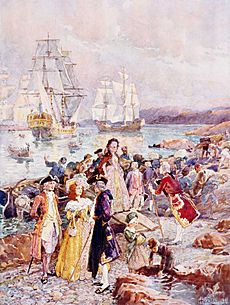
The Loyalists who settled in the Saint John River valley were unhappy being governed from far-off Halifax. So, on June 18, 1784, the British government created a new province for them: New Brunswick. The first governor was Thomas Carleton. In 1785, he chose Sainte-Anne as the capital, which was later renamed Fredericton. About 14,000 Loyalists came to New Brunswick.
At first, New Brunswick's economy was not strong. But things changed when Napoleon Bonaparte's blockade in Europe made Britain need timber from its North American colonies. This boosted the lumber trade in New Brunswick. The province exported huge amounts of timber. This also led to a boom in shipbuilding. Towns like St. Martins became very busy.
From 1800 to 1851, New Brunswick's population grew from 25,000 to 200,000. Many immigrants came from Ireland and Scotland. In the 1850s, political parties started to form.
During this time, Acadians became a minority. They faced challenges, including laws that prevented them from opening their own schools.
In the 1860s, people started talking about uniting the British colonies in North America. They wanted to avoid problems like the American Civil War and increase trade. In 1864, the Charlottetown Conference was held to discuss this idea.
Becoming a Canadian Province (1867–present)
On July 1, 1867, New Brunswick joined with Nova Scotia and the Province of Canada (now Ontario and Quebec) to create the country of Canada.
After Confederation, new challenges arose. A policy called the National Policy in 1879 put high taxes on imported goods. This hurt trade between the Maritimes and New England. The Great Fire of Saint John in 1877 and the decline of shipbuilding also made things difficult. Many people lost their jobs and moved away.
In 1871, the government introduced free education. However, it banned French and religious teaching in public schools. After protests and a riot, these bans were lifted in 1877.
The Irving Group of Companies started in 1881 when James Irving bought a sawmill. Over time, the Irving family bought many businesses and became very wealthy. Today, the Irving Group is a major part of New Brunswick's economy. They own companies in farming, forestry, food, transportation, media, oil, and shipbuilding.
By the early 20th century, the economy slowly improved. Railways helped new industries like textile manufacturing and pulp and paper mills grow. However, unemployment was high for a long time, especially during the Great Depression in the 1930s.
After World War II, New Brunswick's economy grew. The province became home to many plants working on military contracts.
Acadians in northern New Brunswick were often separated from English speakers. Their population grew after Confederation. In 1960, Premier Louis Robichaud started the New Brunswick Equal Opportunity program. This program aimed to make sure everyone in the province had equal access to education, roads, and healthcare. In 1969, his government passed the Official Languages Act, making New Brunswick officially bilingual. This right was later added to the Constitution of Canada in 1982.
The flag of New Brunswick was adopted in 1965. It shows a lion and a ship. The lion represents ties to Europe, and the ship shows the importance of shipping in the past.
Where is New Brunswick?
New Brunswick is shaped roughly like a square. It borders Quebec to the north and the Atlantic Ocean to the east. To the south is the Bay of Fundy, and to the west is the US state of Maine. A narrow strip of land called the isthmus of Chignecto connects New Brunswick to Nova Scotia.
Much of New Brunswick's higher land has thin, acidic soils due to glaciers. These soils are not great for farming but are perfect for the huge forests that cover the province.
New Brunswick's Climate
New Brunswick's climate is more extreme than other Maritime provinces. It has a humid continental climate. This means cold, snowy winters and warm summers. Areas along the Gulf of St. Lawrence have slightly milder winters. The far north has a subarctic climate.
Climate change is affecting New Brunswick. There are more intense rain and snow events, more winter thaws, and less snowpack. The sea level is also rising.
Plants and Animals
Most of New Brunswick is covered by forests that have grown back after being cut down. Long ago, the Maritimes had huge, old-growth forests. Today, less than one percent of these original Acadian forests remain. The World Wide Fund for Nature says the Acadian Forest is endangered.
Forests are home to animals like the bobcat, Canada lynx, and black bear. Large plant-eaters include the moose and white-tailed deer.
Fiddlehead greens are a popular food. They are picked from the Ostrich fern that grows along riverbanks. Furbish's lousewort is a rare plant found only along the upper Saint John River. It is an endangered species.
The deer population in New Brunswick has dropped a lot since 1985.
New Brunswick's Geology

New Brunswick's rocks are very old, ranging from 1 billion to 200 million years old.
During the Carboniferous period, about 340 million years ago, New Brunswick was in a basin near the equator. Sediments built up and formed rocks like the Albert oil shales. The famous Hopewell Rocks were formed from these rocks and shaped by the huge tides of the Bay of Fundy.
Land Features
New Brunswick is entirely within the Appalachian Mountain range. The province's rivers flow into either the Gulf of Saint Lawrence to the east or the Bay of Fundy to the south.
During the last ice age, thick layers of ice covered New Brunswick. These glaciers carved out valleys and left behind large rocks and sand and gravel deposits.
Who Lives in New Brunswick?
The four Atlantic Provinces have the fewest people in Canada. New Brunswick is the third-least populated province. In 2021, it had 775,610 people. The population has grown since then, reaching over 800,000 in 2022.
The Atlantic provinces also have more people living in rural areas. New Brunswick was mostly rural until 1951. Now, about half the population lives in cities and half in rural areas.
New Brunswick's three main urban areas are Greater Moncton (population 157,717), Greater Saint John (population 130,613), and Greater Fredericton (population 108,610).
Different Backgrounds
In the 2001 census, the most common backgrounds reported were British (40%), French Canadian and Acadian (31%), and Irish (18%). People could choose more than one background.
Languages Spoken
According to the 2021 census, the most spoken languages are English (91.94%) and French (41.86%). Other languages include Spanish, Arabic, Tagalog, and Hindi. People could list more than one language they know.
New Brunswick is the only officially bilingual province in Canada. Both English and French are official languages. This means government and public services are available in both languages. There are separate school systems for English and French speakers. About two-thirds of New Brunswickers speak English, and one-third speak French. More people are becoming bilingual, with 34% saying they speak both English and French.
Religious Beliefs
According to the 2021 census, most people in New Brunswick identify as Christian (67.5%). About 29.7% of people reported having no religion. Other religions include Islam, Hinduism, Sikhism, Buddhism, Indigenous Spirituality, and Judaism.
New Brunswick's Economy
Many people in New Brunswick work in the primary sector, which means they produce raw materials. This includes agriculture, forestry, and mining.
Over 13,000 New Brunswickers work in agriculture. They produce over $1 billion worth of products. Half of this comes from crops, especially potatoes. McCain Foods is a huge company that makes frozen potato products. New Brunswick is also Canada's biggest producer of wild blueberries. Other farm products include apples, cranberries, and maple syrup.
About 85% to 90% of New Brunswick is forested. The forestry industry employs nearly 12,000 people and brings in about $437 million in revenue.
Mining has grown in importance since the 1950s. Mines in New Brunswick produce lead, zinc, copper, and potash.
The Irving Group of Companies plays a very big role in New Brunswick's economy. They own many businesses in different industries, including agriculture, forestry, food processing, transportation, media, oil, and shipbuilding.
The United States is New Brunswick's biggest export market. In 2014, nearly $13 billion worth of goods were exported, with refined petroleum making up 63% of that. Other exports include seafood, pulp, paper, and non-metallic minerals. Lobster is a major seafood export.
Tourism is also important. In 2015, visitors spent $441 million in New Brunswick, which brought in $87 million in tax revenue.
Learning in New Brunswick
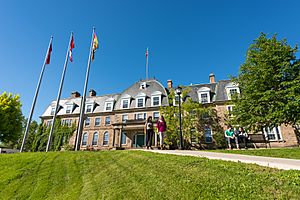
Public schools in New Brunswick are managed by the provincial Department of Education. There are separate school systems for English and French speakers. About 27% of students in the English system are in French immersion programs.
New Brunswick has five public post-secondary schools. These include four public universities and one college. The University of New Brunswick is the oldest English-language university in Canada. Other English universities are Mount Allison University and St. Thomas University. The Université de Moncton is the only French-language university. All these universities offer undergraduate and graduate degrees.
Public colleges are part of the New Brunswick Community College (NBCC) system. The New Brunswick College of Craft & Design is a special college for arts and crafts. There are also private schools like the Moncton Flight College.
Getting Around New Brunswick
The Department of Transportation and Infrastructure manages government buildings, highways, and ferries. The Trans-Canada Highway goes through New Brunswick, connecting Edmundston, Fredericton, Moncton, and then to Nova Scotia and Prince Edward Island.
Train Travel
Via Rail's Ocean train connects Montreal to Halifax. It is the oldest continuously running passenger train route in North America. It stops at many towns in New Brunswick, including Campbellton, Miramichi, and Moncton.
Canadian National Railway operates freight trains on the same route. The New Brunswick Southern Railway (part of J. D. Irving Limited) also runs freight services.
Culture in New Brunswick
Historic Places and Museums
New Brunswick has about 61 historic places. These include Fort Beauséjour, Kings Landing Historical Settlement, and the Village Historique Acadien. The New Brunswick Museum in Saint John was founded in 1842 and is the provincial museum. There are also many other museums across the province.
Music and Theatre
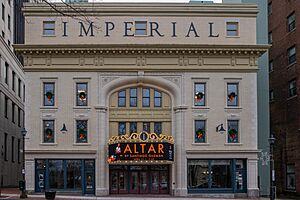
New Brunswick has produced many talented musicians like Henry Burr, Roch Voisine, and Édith Butler. Symphony New Brunswick is based in Saint John and performs throughout the province. The Atlantic Ballet Theatre of Canada also performs nationally and internationally.
Theatre New Brunswick tours plays around the province. Other theatres include the Théatre populaire d'Acadia in Caraquet and the Imperial in Saint John.
Visual Arts
New Brunswick has many art galleries. The Beaverbrook Art Gallery was named the provincial art gallery in 1994. The Galerie d’art Louise-et-Reuben-Cohen is at the Université de Moncton.
Mount Allison University is known for its art program, which started in 1854. The Owens Art Gallery at Mount Allison University is the oldest university art gallery in Canada.
Famous New Brunswick artists include landscape painter Jack Humphrey and sculptor Claude Roussel.
Literature
Julia Catherine Beckwith, from Fredericton, was Canada's first published novelist. Poets Bliss Carman and Charles G. D. Roberts were among the first Canadians to become famous internationally for their writing. Antonine Maillet was the first non-European to win France's Prix Goncourt literary prize. Other modern writers include Alden Nowlan and David Adams Richards. The Fiddlehead, started in 1945, is Canada's oldest literary magazine.
Media
New Brunswick has four daily newspapers: the Times & Transcript, the Telegraph-Journal, The Daily Gleaner, and L'Acadie Nouvelle (in French). Most of the English newspapers are owned by Brunswick News, which is part of the Irving Group of Companies.
The Canadian Broadcasting Corporation (CBC) has English TV and radio stations in Fredericton. Télévision de Radio-Canada (French CBC) is based in Moncton. Other TV networks like CTV and Global also have stations in New Brunswick.
There are also 34 radio stations in New Brunswick, broadcasting in English or French.
See also
 In Spanish: Nuevo Brunswick para niños
In Spanish: Nuevo Brunswick para niños




